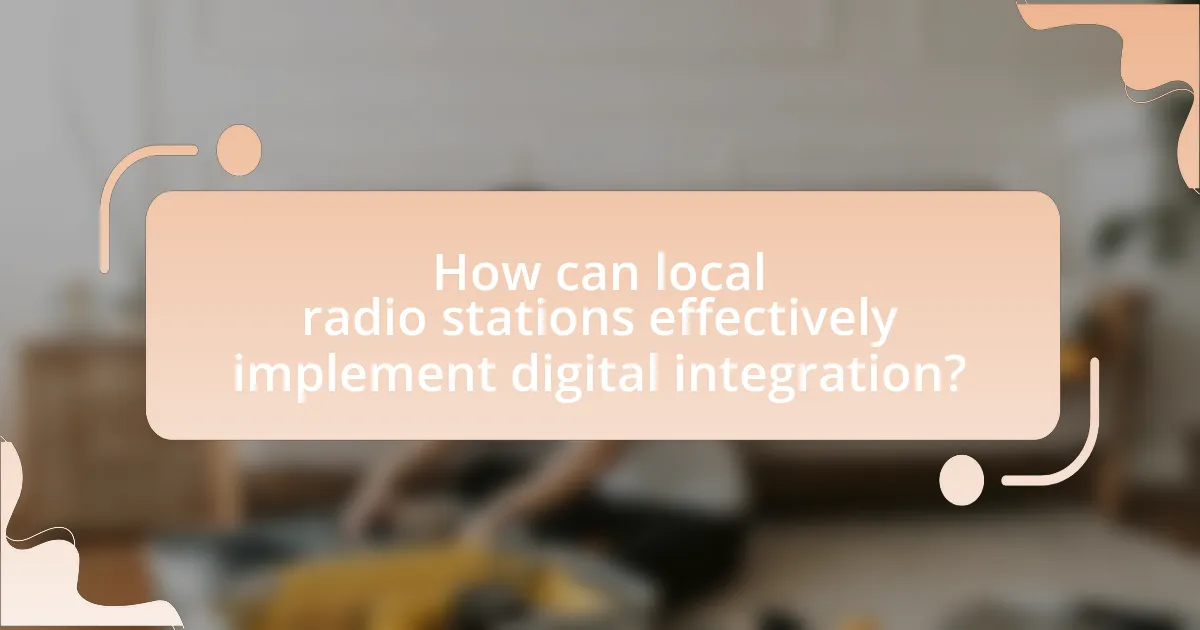The article focuses on the future of digital integration in local radio advertising, highlighting how advancements in technology and data analytics are transforming the industry. It discusses the importance of targeted advertising, enhanced audience engagement, and the role of social media and streaming services in reaching wider demographics. Key trends such as programmatic advertising and the use of real-time analytics are examined, along with the challenges local radio stations face without digital integration. The article also outlines practical steps for effective implementation, emphasizing the long-term benefits of embracing digital strategies for increased reach and advertising effectiveness.

What is the Future of Digital Integration in Local Radio Advertising?
The future of digital integration in local radio advertising is characterized by enhanced targeting and interactivity through data-driven strategies. As local radio stations increasingly adopt digital platforms, they can leverage listener data to create personalized advertising experiences, improving engagement and effectiveness. For instance, according to a report by the Radio Advertising Bureau, digital ad spending in radio is projected to grow significantly, indicating a shift towards integrating digital tools for better audience reach. This integration allows for real-time analytics, enabling advertisers to adjust campaigns based on listener behavior and preferences, thereby maximizing return on investment.
How is digital integration transforming local radio advertising?
Digital integration is transforming local radio advertising by enabling targeted advertising and enhancing audience engagement through data analytics and online platforms. Local radio stations can now leverage digital tools to gather listener data, allowing advertisers to create personalized campaigns that reach specific demographics. For instance, a study by the Radio Advertising Bureau found that targeted ads can increase listener response rates by up to 30%. Additionally, the integration of social media and streaming services allows local radio to interact with audiences in real-time, fostering a more dynamic advertising environment. This shift not only improves the effectiveness of advertising but also helps local stations compete with larger media outlets by offering unique, data-driven advertising solutions.
What technologies are driving digital integration in local radio?
Digital integration in local radio is primarily driven by streaming technologies, mobile applications, and data analytics. Streaming technologies enable real-time broadcasting and on-demand content access, allowing local radio stations to reach wider audiences beyond traditional FM/AM frequencies. Mobile applications facilitate user engagement and provide listeners with personalized content, enhancing the overall listening experience. Data analytics tools empower local radio stations to gather insights on listener preferences and behaviors, enabling targeted advertising and content curation. These technologies collectively enhance the operational efficiency and audience reach of local radio, aligning with the evolving landscape of digital media consumption.
How does digital integration enhance audience engagement in local radio?
Digital integration enhances audience engagement in local radio by enabling interactive platforms that facilitate real-time communication and feedback. This integration allows listeners to participate in polls, contests, and discussions through social media and mobile apps, fostering a sense of community and involvement. For instance, a study by the Pew Research Center found that 62% of radio listeners engage with stations via social media, indicating that digital tools significantly increase listener interaction and loyalty. Furthermore, local radio stations can utilize data analytics to tailor content to audience preferences, ensuring that programming resonates with listeners, thereby enhancing overall engagement.
Why is digital integration important for local radio advertising?
Digital integration is important for local radio advertising because it enhances audience engagement and expands reach through multiple platforms. By integrating digital tools, local radio stations can leverage social media, websites, and mobile apps to create interactive campaigns that resonate with listeners. For instance, a study by the Pew Research Center found that 64% of Americans engage with radio content online, indicating a significant overlap between traditional radio and digital platforms. This integration allows advertisers to target specific demographics more effectively, track listener behavior, and measure campaign performance in real-time, ultimately leading to higher return on investment for local businesses.
What challenges do local radio stations face without digital integration?
Local radio stations face significant challenges without digital integration, primarily in audience reach and revenue generation. Without digital platforms, these stations struggle to connect with younger demographics who predominantly consume content online, leading to a decline in listener numbers. According to a 2021 Nielsen report, 63% of adults aged 18-34 listen to radio via digital platforms, highlighting the necessity for local stations to adapt. Additionally, without digital advertising capabilities, local radio stations miss out on lucrative online ad revenue, which has been growing at a rate of 12% annually, as reported by eMarketer. This lack of integration ultimately hampers their competitiveness against larger media conglomerates that leverage digital tools for broader outreach and diversified income streams.
How can digital integration improve advertising effectiveness for local businesses?
Digital integration can significantly improve advertising effectiveness for local businesses by enhancing targeting capabilities and increasing engagement. By utilizing data analytics and digital platforms, local businesses can identify specific demographics and consumer behaviors, allowing for tailored advertising that resonates with the intended audience. For instance, a study by the Local Media Association found that businesses leveraging digital tools saw a 30% increase in customer engagement compared to traditional advertising methods. This targeted approach not only maximizes advertising spend but also fosters stronger connections with the community, ultimately driving sales and brand loyalty.

What trends are shaping the future of digital integration in local radio advertising?
The future of digital integration in local radio advertising is being shaped by trends such as increased use of data analytics, the rise of programmatic advertising, and the integration of social media platforms. Data analytics allows advertisers to target specific demographics more effectively, enhancing the relevance of ads and improving ROI. Programmatic advertising automates the buying and selling of ad space, making it more efficient and cost-effective for local stations. Additionally, social media integration enables radio stations to engage listeners across multiple platforms, fostering a more interactive experience. These trends are supported by industry reports indicating that digital ad spending is projected to grow significantly, with local radio adapting to maintain its relevance in an evolving media landscape.
How are consumer behaviors influencing digital strategies in local radio?
Consumer behaviors are significantly influencing digital strategies in local radio by driving the need for personalized content and targeted advertising. As listeners increasingly prefer on-demand and mobile-accessible content, local radio stations are adapting their digital strategies to include streaming services, social media engagement, and personalized advertising based on listener data. For instance, a Nielsen report indicates that 54% of radio listeners engage with radio content through digital platforms, highlighting the necessity for local stations to integrate digital strategies that cater to these behaviors. This shift not only enhances listener engagement but also improves advertising effectiveness by allowing for more precise targeting based on consumer preferences and behaviors.
What role does social media play in local radio advertising integration?
Social media serves as a crucial platform for local radio advertising integration by enhancing audience engagement and expanding reach. Local radio stations utilize social media to promote their content, interact with listeners, and share advertisements, thereby creating a multi-channel marketing approach. According to a 2021 Nielsen report, 60% of radio listeners also engage with social media, indicating that integrating these platforms can significantly amplify advertising effectiveness. This synergy allows advertisers to target specific demographics more accurately and track engagement metrics in real-time, ultimately leading to improved campaign outcomes.
How are data analytics being utilized in local radio advertising?
Data analytics are utilized in local radio advertising to enhance targeting, optimize ad placements, and measure campaign effectiveness. By analyzing listener demographics, preferences, and behaviors, radio stations can tailor their advertising strategies to reach specific audiences more effectively. For instance, data from Nielsen Audio shows that stations can identify peak listening times and preferred content types, allowing advertisers to schedule their ads when they are most likely to reach their target demographic. Additionally, analytics enable the assessment of ad performance through metrics such as listener engagement and response rates, providing concrete feedback that informs future advertising decisions.
What innovations are emerging in local radio advertising due to digital integration?
Innovations emerging in local radio advertising due to digital integration include targeted advertising, programmatic buying, and enhanced listener engagement through interactive content. Targeted advertising allows local stations to deliver personalized ads based on listener demographics and behaviors, increasing relevance and effectiveness. Programmatic buying automates the ad purchasing process, enabling real-time bidding and optimizing ad placements for better ROI. Enhanced listener engagement is achieved through interactive content, such as social media integration and mobile app features, which allow listeners to participate in polls, contests, and feedback, fostering a more connected community. These innovations are supported by data analytics that provide insights into listener preferences and ad performance, driving more strategic advertising decisions.
How are programmatic advertising and automation changing local radio?
Programmatic advertising and automation are transforming local radio by enabling more targeted and efficient ad placements. This shift allows advertisers to leverage data analytics for audience segmentation, ensuring that ads reach specific demographics at optimal times. According to a report by eMarketer, programmatic ad spending in the U.S. is projected to exceed $100 billion by 2023, indicating a significant trend towards automated solutions in advertising. As a result, local radio stations can optimize their inventory management and increase revenue through real-time bidding and dynamic ad insertion, enhancing the overall effectiveness of their advertising strategies.
What new formats are being adopted in local radio advertising?
Local radio advertising is increasingly adopting digital integration formats such as programmatic advertising, podcast sponsorships, and interactive audio ads. Programmatic advertising allows for automated buying and selling of ad space, enhancing targeting and efficiency. Podcast sponsorships leverage the growing popularity of on-demand audio content, enabling advertisers to reach niche audiences effectively. Interactive audio ads engage listeners by prompting them to take action, such as visiting a website or participating in a survey, thus increasing listener interaction and ad effectiveness. These formats reflect the industry’s shift towards more personalized and data-driven advertising strategies.

How can local radio stations effectively implement digital integration?
Local radio stations can effectively implement digital integration by adopting multi-platform strategies that enhance audience engagement and expand their reach. This includes creating a robust online presence through websites and social media, utilizing streaming services to broadcast live shows, and offering on-demand content to cater to listener preferences. According to a 2022 Nielsen report, 62% of radio listeners also engage with radio content online, indicating a significant opportunity for local stations to connect with their audience digitally. Additionally, integrating data analytics tools allows stations to better understand listener behavior and preferences, enabling targeted advertising and personalized content delivery.
What best practices should local radio stations follow for digital integration?
Local radio stations should prioritize a multi-platform approach for digital integration, ensuring their content is accessible across various digital channels. This includes maintaining a strong online presence through websites and social media, which allows for audience engagement and content sharing. Additionally, utilizing data analytics to understand listener preferences can enhance targeted advertising and programming strategies. According to a 2022 Nielsen report, radio stations that effectively integrate digital platforms see a 30% increase in listener engagement, demonstrating the importance of adapting to digital trends.
How can local radio stations measure the success of their digital integration efforts?
Local radio stations can measure the success of their digital integration efforts through key performance indicators (KPIs) such as audience engagement metrics, digital ad revenue growth, and listener feedback. Audience engagement metrics, including website traffic, social media interactions, and app downloads, provide quantifiable data on how well the digital content resonates with listeners. For instance, a study by the Pew Research Center found that 54% of adults in the U.S. listen to online radio, indicating a significant audience shift towards digital platforms. Additionally, tracking digital ad revenue growth compared to traditional revenue can highlight the financial impact of digital strategies. Listener feedback, gathered through surveys and social media, offers qualitative insights into audience perceptions and preferences, further informing the effectiveness of digital integration.
What partnerships can enhance digital integration in local radio advertising?
Strategic partnerships with digital marketing agencies, social media platforms, and technology providers can enhance digital integration in local radio advertising. Digital marketing agencies can offer expertise in online advertising strategies, helping local radio stations to reach broader audiences through targeted campaigns. Collaborating with social media platforms allows radio stations to leverage their vast user bases for promotional activities, increasing engagement and listener interaction. Additionally, partnerships with technology providers can facilitate the integration of advanced analytics and automation tools, enabling radio stations to optimize ad placements and measure campaign effectiveness. These collaborations are essential for adapting to the evolving digital landscape and maximizing advertising revenue.
What common pitfalls should local radio stations avoid in digital integration?
Local radio stations should avoid the pitfall of neglecting audience engagement during digital integration. Engaging listeners through interactive content and social media is crucial, as studies show that stations with active listener participation see a 30% increase in audience retention. Additionally, failing to optimize content for mobile platforms can alienate a significant portion of the audience; research indicates that over 70% of digital radio consumption occurs on mobile devices. Lastly, overlooking data analytics can hinder effective targeting and personalization, which are essential for maximizing advertising revenue; data-driven strategies have been shown to improve ad effectiveness by up to 50%.
How can local radio stations ensure they are not overwhelmed by technology?
Local radio stations can ensure they are not overwhelmed by technology by adopting a strategic approach to digital integration that prioritizes training and gradual implementation. By investing in staff training programs, stations can enhance their team’s technical skills, enabling them to effectively utilize new technologies without feeling overwhelmed. For instance, a study by the Pew Research Center indicates that 70% of radio professionals believe that ongoing training is essential for adapting to technological changes. Additionally, local radio stations should implement technology incrementally, allowing time for staff to adjust and providing opportunities for feedback. This method reduces the risk of disruption and fosters a culture of adaptability, ensuring that technology serves to enhance, rather than complicate, their operations.
What strategies can help local radio stations maintain their unique identity while integrating digitally?
Local radio stations can maintain their unique identity while integrating digitally by focusing on community engagement, personalized content, and leveraging local talent. Community engagement allows stations to foster a strong connection with their audience, which is essential for retaining their local identity. For instance, hosting local events or collaborating with local businesses can enhance visibility and relevance. Personalized content, such as tailored programming that reflects local interests and issues, helps differentiate stations from larger, national broadcasters. Additionally, leveraging local talent, including DJs and news reporters who understand the community, reinforces the station’s unique voice. According to a 2021 study by the Pew Research Center, local news and information are highly valued by audiences, indicating that stations that prioritize local content are more likely to succeed in a digital landscape.
What are the future implications of digital integration for local radio advertising?
Digital integration will significantly enhance local radio advertising by enabling targeted marketing and real-time analytics. As local radio stations adopt digital platforms, they can leverage data to understand listener preferences and behaviors, allowing advertisers to create personalized campaigns that resonate with specific demographics. For instance, a study by the Pew Research Center indicates that 60% of radio listeners are more likely to engage with ads tailored to their interests. Additionally, the integration of social media and streaming services will facilitate cross-platform advertising, increasing reach and engagement. This shift towards a data-driven approach will likely lead to higher ROI for advertisers, as they can measure the effectiveness of their campaigns in real-time and adjust strategies accordingly.
How might consumer expectations evolve with increased digital integration?
Consumer expectations will likely evolve towards a demand for personalized, seamless, and immediate interactions with brands due to increased digital integration. As digital technologies become more prevalent, consumers will expect tailored content and experiences that align with their preferences and behaviors. For instance, a study by Salesforce found that 70% of consumers say a company’s understanding of their personal needs influences their loyalty. This indicates that as digital integration deepens, consumers will increasingly anticipate brands to leverage data analytics for personalized marketing, resulting in higher engagement and satisfaction.
What long-term benefits can local radio stations expect from embracing digital integration?
Local radio stations can expect increased audience reach and engagement as long-term benefits from embracing digital integration. By utilizing digital platforms, stations can expand their listenership beyond traditional geographic boundaries, allowing them to connect with a global audience. For instance, a study by the Pew Research Center found that 57% of Americans listen to online radio, indicating a significant shift towards digital consumption. Additionally, digital integration enables local stations to gather listener data, facilitating targeted advertising and personalized content, which can enhance listener loyalty and increase advertising revenue. This data-driven approach is supported by research from the Nielsen Company, which shows that targeted ads can lead to a 30% increase in effectiveness compared to non-targeted ads.
What practical steps can local radio stations take to enhance their digital integration?
Local radio stations can enhance their digital integration by developing a robust online presence through websites and social media platforms. This includes creating engaging content that resonates with their audience, such as podcasts, live streaming, and interactive social media posts. According to a 2021 Nielsen report, 62% of radio listeners also engage with radio stations online, highlighting the importance of digital engagement. Additionally, local radio stations should invest in data analytics tools to better understand listener preferences and tailor their content accordingly. Implementing targeted advertising strategies that leverage digital platforms can also increase revenue and listener engagement, as evidenced by the 2022 IAB report, which indicated that digital audio advertising grew by 57% year-over-year.